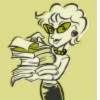 Pinkney, Andrea Davis, and Brian Pinkney. 2002. ELLA FITZGERALD: THE TALE OF A VOCAL VIRTUOSA. New York, NY: Jump at the Sun/Hyperion Books for Children. ISBN 0-786805684
Pinkney, Andrea Davis, and Brian Pinkney. 2002. ELLA FITZGERALD: THE TALE OF A VOCAL VIRTUOSA. New York, NY: Jump at the Sun/Hyperion Books for Children. ISBN 0-786805684PLOT SUMMARY:
ELLA FITZGERALD: THE TALE OF A VOCAL VIRTUOSA is an account of some of the high points in Ella Fitzgerald’s life. Told from the perspective of Scat Cat Monroe who was there from “the get-go,” the story follows Ella’s life from dancing on the street corner to becoming honored by two U.S. Presidents for her talent. Infused with period terminology, Pinkney’s version of Fitzgerald’s life may be difficult for young readers to understand. However, older readers and people familiar with her work will love the celebration of Ella’s successes through both text and delightful illustrations.
CRITICAL ANALYSIS:
Andrea Davis Pinkney and Brian Pinkney team up to produce a vibrant retelling of Ella Fitzgerald’s musical career. This nonfiction piece utilizes accuracy, organization, design and style to relay the story. The incorporation of African-American culture further contributes to the story’s meaning and overall presentation.
The accuracy of this book is validated by the author’s research. In collaboration with Quincy Troupe and the Carnegie Hall Archives, Pinkney’s story is wholly believable. In addition to research done at the Museum of the City of New York, Pinkney offers a bibliography to support the facts presented in ELLA FITZGERALD. At the end of the book is a listing of resources, including books, videos, and records. Whether or not they are interested in continuing to learn about The Queen of Scat, older readers will find these items both interesting and entertaining.
Each era in Ms. Fitzgerald’s life is organized into a “track” (chapter). The tracks follow Ms. Fitzgerald from dancing on the street corners in her home town of Yonkers, New York, through her rise in popularity as a singer in Harlem, to nationwide recognition. The book ends hailing her legendary status as The First Lady of American Song. Scat Cat Monroe, a self-proclaimed expert on Ella Fitzgerald, is the reader’s guide.
The illustrations are sometimes surreal and always embody the music they celebrate. The musicians and dancers portrayed in ELLA FITZGERALD illustrate African-American music and culture during jazz’s swing and bebop popularity. Brightly colored suits and dresses and wing-tip shoes adorn each character. Brian Pinkney’s scratchboard technique, bright colors, and ability to convey movement make the illustrations the best part of this biography.
The culture of this book is demonstrated via voice and vocabulary. The narrator, Scat Cat Monroe, embodies Harlem and jazz in the thirties. “Baby, I’m in a class all by myself.” Later, Scat Cat refers to another musician as “a finicky bird. Easy to ruffle.” These phrases and others, such as strut her shuffle, shade the high notes, grits with gravy, milked the backbeat, and ham-hock jabber offer a window to the culture of the music scene in Harlem in the 1930s. However, they are overused and potentially confusing—especially for English language learners. On the other hand, the racial issues of the time are mentioned only in passing, “…a true star has no color.”
This account of Ella Fitzgerald’s life is by no means exhaustive. By offering a list of references in a variety of formats at the end of the book, as well as comprehensive Notes from the author and illustrator, readers are encouraged to study jazz and the contributions made by the Vocal Virtuosa.
REVIEW EXCERPTS:
"The prose, while occasionally labored, swings to a syncopated beat and piles on the synesthesia ("Ella rolled out a tune sweet enough to bake"). …A `skippity-hop-doo-dee-bop' picture book." (Publisher’s Weekly)
"In a playful, conversational tone, this work nearly sings the rhythms of scat. …Bright colors, jazzy words, and energetic artwork bring the music of scat and Fitzgerald to life." (School Library Journal)
CONNECTIONS:
Other books by Pinkney about African Americans:
DUKE ELLINGTON: THE PIANO PRINCE AND HIS ORCHESTRA
ALVIN AILEY
DEAR BENJAMIN BANNEKER
LET IT SHINE: STORIES OF BLACK WOMEN FREEDOM FIGHTERS
BILL PICKETT: RODEO-RIDIN’ COWBOY
Other books about Jazz
DUKE ELLINGTON: THE PIANO PRINCE AND HIS ORCHESTRA by Andrea D. Pinkney
CHARLIE PARKER PLAYED BE BOP by Chris Rascka
DIZZY by Jonah Winter
JOHN COLTRANE’S GIANT STEPS by Chris Raschka


